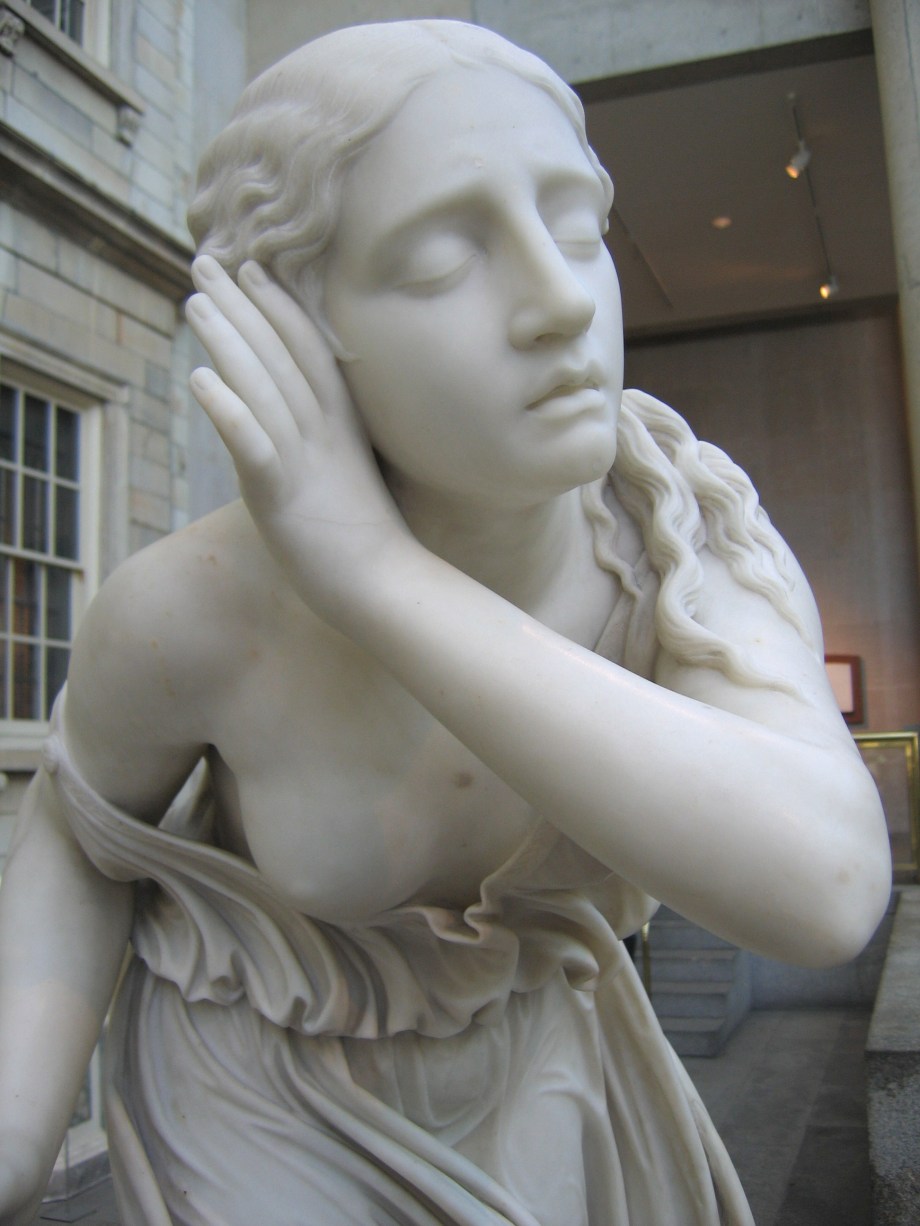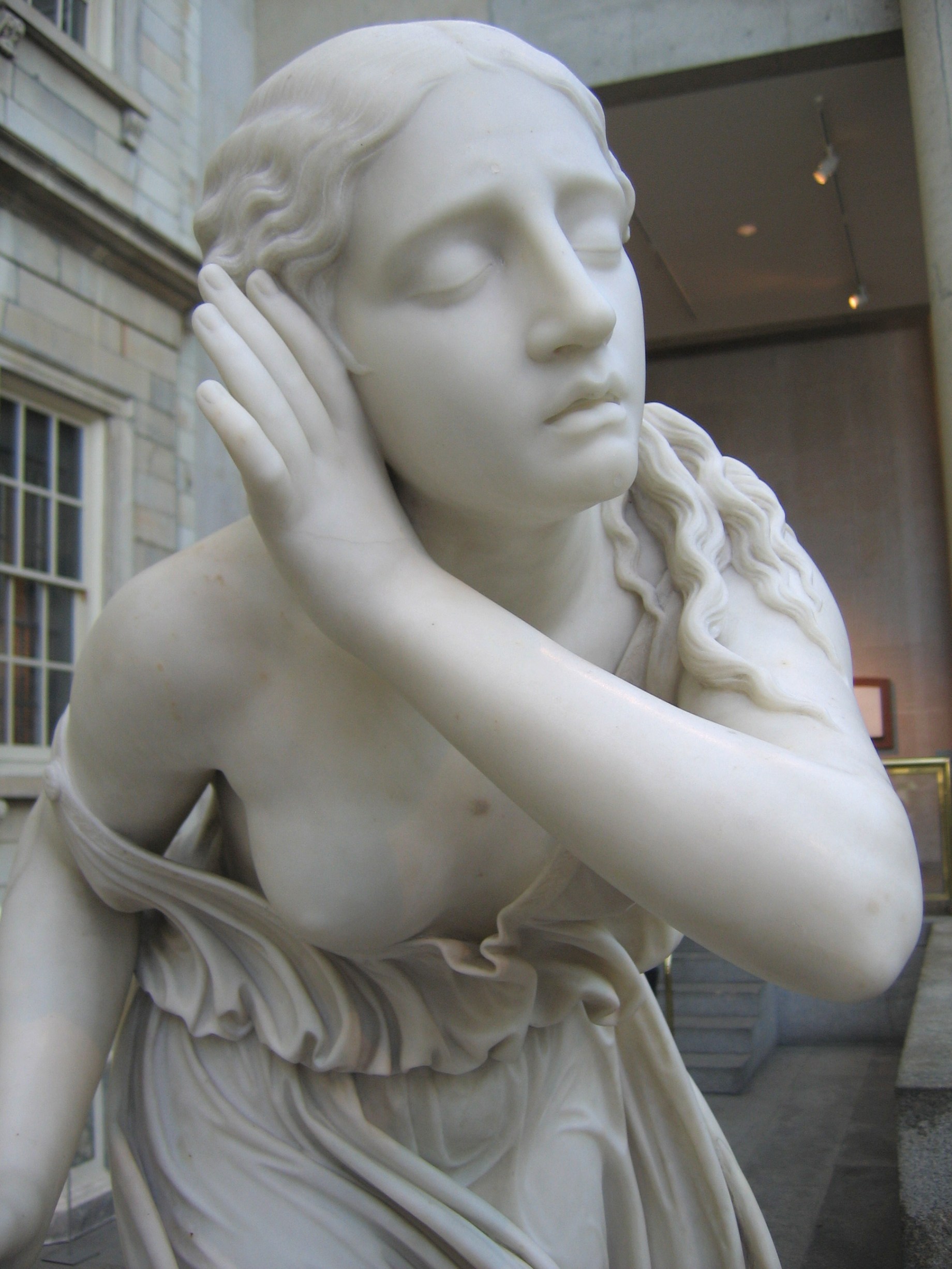In all my travels, I’ve seen her at least three times.Each time, we end up being in an odd spot where I feel bad for her, but also impressed by her beauty. I stare at her face, the smooth marble finished so perfectly and her expression so intense. I could spend few true minutes uninterrupted trying to understand, but in the end, I would forget her name until I found her again in another museum. Until last night, all I knew was that I loved and hated this statue.

Her name is Nydia, the Flower Girl of Pompeii. She is a marble statue designed by Randolph Rogers (1825-1892), an American sculptor. The most famous and popular work by Rogers, there were at least 50 copies made. There seems to be a copy in most major US museums. She is a character from a novel by Edward Bulwer-Lytton, named the Last Days of Pompeii. Nydia is a slave, kidnapped from a wealthy family and forced to sell flower crowns for her rich owners. She falls in love with a man, Glaucus who is engaged to a woman named Ione. Nydia is blind, so when the city is being destroyed by Vesuvius’ explosion, she tries to guide them to safety as she is used to moving through the city in utter darkness. They become separated, and Nydia realizes Glaucus will never love her. She then drowns herself, after she effectively reaches safety.
The problem I have with Nydia is truly not her fault, but with her creation. She was in a story written by a man of considerable social power in order to add complication to a male protagonist’s story. Suicide is the best way to tie up her story, as she is only there for tragedy. While I understand that she is only a character, the way she is depicted is through her weakness or attractiveness.
It continues with the statue. She is a beautiful woman expressing fear, but there is little else there. Her title is almost always, “Nydia, the Blind Girl of Pompeii.” It gives a lot away. With only her first name, she is unidentifiable except for her tie to the book. To use the word blind as her only one personal descriptor, puts that above all else that would make her an individual. He calls her girl, when at the time in Roman Society, she would be considered a women. Still a member of an abused part of society, using woman would have made her importance more relevant. Also, by evoking Pompeii, she is clearly tied to the end of the tragedy, and not her heroism.
What really bothers me is not just the title, because that can be more impacted by marketing than anything else. A title like that is understandable for its intended audiences: Victorians that were obsessed with Pompeii and convoluted tragedies. They would have some sort of awareness of the Last Days of Pompeii. What irritates me is that her hair is perfect and her right breast is just hanging out. In a moment of death and destruction, these details make little sense. The garment would just not flow so sensually over her body to perfectly reveal her breast. It wouldn’t also carefully capture legs and sexualize them. Her hair would either be signed or entirely fallen out of any hairstyle. Nydia would look like a terrified, soot covered mess, not like a woman who just had sex.

This is classic Male Gaze: to take a woman from the lowest part of society, to give her a story where she has no agency, to kill her because she cannot survive without her love, and then recreate her as a sex symbol. This is the kind of works of art that upset me, because they make my identity as a woman seem of less value. This is the kind of work that continues a narrative that woman are only so interesting as their love lives.
Yet, on the flip side, I love this work because it singles out a woman who did try her best to save other people. Even if the story isn’t told here, it exists in part. Nydia is remembered more than the man she loved because of this artwork. I love it because it’s carved so well and evocative of a single moment. It feels like I could be right there with her, trying to survive the destruction of an entire city. I love it because I love the Victorian Era and its art because of its blend of complex stories and beauty.
How to balance my feminism with the reality of Art History? It is has, and continues to be, a world dominated by male stories. Women often do not get to tell their own stories, so they are missing or invalidated. I’m not sure I will ever have an answer of how to be comfortable with works that have silenced women while also being stunning. I do know that each time I see Nydia, I will be both awestruck and somewhat hurt by the neglect done to women throughout Art History.
